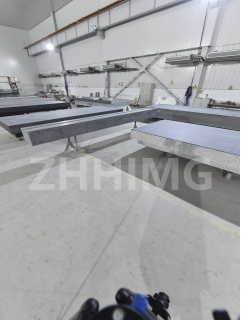Industrial computed tomography has become an integral part of various industries wherein high-precision imaging is required. In the context of industrial computed tomography, granite components have gained immense popularity due to their unique advantages. Moreover, granite is a natural material that is abundant and easily sourced. In this article, we will discuss the advantages and disadvantages of granite components in industrial computed tomography.
Advantages of Granite Components in Industrial Computed Tomography
1. High Stability and Durability: Granite is an extremely stable and durable material that can effectively resist vibrations and thermic expansions. This is crucial in computed tomography as the slightest disturbance or distortion can affect the imaging output. Granite components provide a stable and vibration-free platform, which results in high-quality scanning results.
2. High Precision: Granite is a highly precise material that has a low coefficient of thermal expansion. This means that the material does not expand or contract when subjected to temperature changes. This is important in computed tomography as temperature variations can cause the sensor to distort, resulting in inaccurate imaging. Granite components can maintain a precise position for an extended period, which is crucial for industrial applications.
3. Low Wear and Tear: The wear and tear on granite components are relatively low compared to other materials used in computed tomography. Granite components are also resistant to corrosion and abrasion, which is essential in industrial environments. The resistance to wear and tear ensures that the equipment can be used for an extended period without the need for constant repairs or replacements.
4. Better Image Quality: The high precision and low wear and tear of granite components lead to better image quality. The surfaces of granite are smoother and more uniform than other materials used in computed tomography. This ensures that the image produced is clearer and more precise, without any distortions or irregularities.
Disadvantages of Granite Components in Industrial Computed Tomography
1. Expensive: Granite is a relatively expensive material compared to other materials used in computed tomography. This is due to the complex process involved in sourcing and shaping the material. The high cost of granite components can increase the overall cost of the industrial computed tomography equipment.
2. Heavy: Granite is a dense material that is relatively heavy compared to other materials used in computed tomography. This means that the equipment needs to be carefully designed to accommodate the added weight of the granite components. Furthermore, the added weight can make it difficult to move the equipment from one location to another.
Conclusion
In conclusion, granite components in industrial computed tomography have several advantages that make them a popular choice among manufacturers. The high stability, precision, low wear and tear, and better image quality are among the main advantages. However, the high cost and heavy weight of the material are some of the downsides that need to be considered carefully. Despite these disadvantages, granite components remain an ideal choice for high-precision and high-quality computed tomography imaging in industrial applications.
Post time: Dec-07-2023

